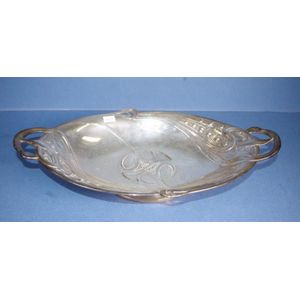Art Nouveau Pewter Nymph Dish
You must be a subscriber, and be logged in to view price and dealer details.
Subscribe Now to view actual auction price for this item
When you subscribe, you have the option of setting the currency in which to display prices to $Au, $US, $NZ or Stg.
- Circa - A Latin term meaning 'about', often used in the antique trade to give an approximate date for the piece, usually considered to be five years on either side of the circa year. Thus, circa 1900 means the piece was made about 1900, probably between 1895 and 1905. The expression is sometimes abbreviated to c.1900.
- Art Nouveau Period - The Art Nouveau period was a cultural movement that emerged in the late 19th century, and was characterized by its emphasis on natural forms, flowing lines, and a decorative, ornamental style. Art Nouveau was a reaction against the ornate and heavily stylized designs of the previous era, and sought to create a new, more organic aesthetic.
Art Nouveau was characterized by its use of sinuous, curving lines, as well as a focus on natural elements such as flowers, vines, and other organic shapes. Art Nouveau designers sought to create a total work of art, in which every element of a building or object was designed to be harmonious with the overall design.
Some of the most iconic examples of Art Nouveau design include the Paris Metro entrances designed by Hector Guimard, the works of the artist Alphonse Mucha, and the architecture of Victor Horta in Brussels.
The Art Nouveau period was at its peak between 1890 and 1910, but began to decline in popularity by the start of World War I. However, Art Nouveau remains an important influence on design and art to this day, and continues to be celebrated for its emphasis on natural forms and decorative style.
This item has been included into following indexes:
- silver, country of manufacture - German 583
- trays, silver
Visually similar items

An oval silver-plated gallery footed tray, 45 x 30 cm

A Rene Lalique Pinsons pattern sepia patinated bowl, moulded with a lattice pattern of fronds with sparrows, incised Lalique France to base. Model introduced 1933. Diameter 24 cm.

A Canadian silver dish, oval form with four large grape clusters in repousse; Birks, Montreal, 1959. Length 28 cm, width 18 cm. Weight 170g.

Art Nouveau WMF 'Lilly of the Valley' platter, silver plated with twin handles, 40 cm wide.
